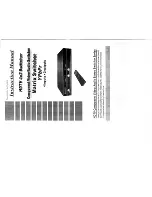
216
C
HAPTER
17: 802.1
X
C
ONFIGURATION
802.1x Authentication
Procedure
The Switch 4210 can authenticate supplicant systems in EAP terminating mode or
EAP relay mode.
EAP relay mode
This mode is defined in 802.1x. In this mode, EAP-packets are encapsulated in
higher level protocol (such as EAPoR) packets to enable them to successfully reach
the authentication server. Normally, this mode requires that the RADIUS server
support the two newly-added fields: the EAP-message field (with a value of 79)
and the Message-authenticator field (with a value of 80).
Four authentication ways, namely EAP-MD5, EAP-TLS (transport layer security),
EAP-TTLS (tunneled transport layer security), and PEAP (protected extensible
authentication protocol), are available in the EAP relay mode.
■
EAP-MD5 authenticates the supplicant system. The RADIUS server sends MD5
keys (contained in EAP-request/MD5 challenge packets) to the supplicant
system, which in turn encrypts the passwords using the MD5 keys.
■
EAP-TLS allows the supplicant system and the RADIUS server to check each
other’s security certificate and authenticate each other’s identity, guaranteeing
that data is transferred to the right destination and preventing data from being
intercepted.
■
EAP-TTLS is a kind of extended EAP-TLS. EAP-TLS implements bidirectional
authentication between the client and authentication server. EAP-TTLS transmit
message using a tunnel established using TLS.
■
PEAP creates and uses TLS security channels to ensure data integrity and then
performs new EAP negotiations to verify supplicant systems.
Figure 72 describes the basic EAP-MD5 authentication procedure.
Summary of Contents for 4210 PWR
Page 22: ...20 CHAPTER 1 CLI CONFIGURATION...
Page 74: ...72 CHAPTER 3 CONFIGURATION FILE MANAGEMENT...
Page 84: ...82 CHAPTER 5 VLAN CONFIGURATION...
Page 96: ...94 CHAPTER 8 IP PERFORMANCE CONFIGURATION...
Page 108: ...106 CHAPTER 9 PORT BASIC CONFIGURATION...
Page 122: ...120 CHAPTER 11 PORT ISOLATION CONFIGURATION...
Page 140: ...138 CHAPTER 13 MAC ADDRESS TABLE MANAGEMENT...
Page 234: ...232 CHAPTER 17 802 1X CONFIGURATION...
Page 246: ...244 CHAPTER 20 AAA OVERVIEW...
Page 270: ...268 CHAPTER 21 AAA CONFIGURATION...
Page 292: ...290 CHAPTER 26 DHCP BOOTP CLIENT CONFIGURATION...
Page 318: ...316 CHAPTER 29 MIRRORING CONFIGURATION...
Page 340: ...338 CHAPTER 30 CLUSTER...
Page 362: ...360 CHAPTER 33 SNMP CONFIGURATION...
Page 368: ...366 CHAPTER 34 RMON CONFIGURATION...
Page 450: ...448 CHAPTER 39 TFTP CONFIGURATION...
Page 451: ......
Page 452: ...450 CHAPTER 39 TFTP CONFIGURATION...
Page 470: ...468 CHAPTER 40 INFORMATION CENTER...
Page 496: ...494 CHAPTER 44 DEVICE MANAGEMENT...
















































